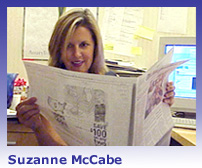
|
|
 Listen to Suzanne as she discusses the difficulties of starting to write a news article. Listen to Suzanne as she discusses the difficulties of starting to write a news article.
(You need the Real Player 7.0 or higher to hear the audio.
Download it now. It will take about 5 or 10 minutes.)
Suzanne McCabe is the Managing Editor of Junior Scholastic. For more than 10 years, she has contributed feature articles and plays on news, history, and literature to Scholastic's classroom magazines. As a Scholastic reporter, Suzanne has covered the Republican and Democratic conventions with kid reporters and traveled along the trail of Lewis and Clark with documentary filmmaker Ken Burns and historian Stephen Ambrose. She also covered a White House conference on school violence hosted by President and Mrs. Clinton and visited Navajo teens in Ganado, Arizona, and Thoreau, New Mexico.
"Find something you love to do," she advises kids, "whether it's writing, acting, or effecting social change. Then find others who do it extremely well. Learn everything you can from your heroes. But don't expect them to be perfect — especially if you're not perfect yourself."
|
|
Here are some thoughts by Suzanne McCabe on how to start writing your
news story now that you've come up with a topic.
You made dozens of phone calls and read every article you could find on the Web. You tracked down experts, scholars, pundits... You even interviewed your next-door neighbor.
Now it's time to sit down and write. Help!
Whether you're writing a news story, a book review, or a novel, getting started can be the toughest part. You need to win over your readers instantly. Otherwise, you may lose them after the first paragraph.
Ready to accept the challenge?
First, think about your assignment. Let's say your editor has asked you to cover a debate between the presidential candidates. That means you need to write a news story. A news story gives readers key information about a recent event.
Before You Begin
Using the information you gathered in the research and interview phase, answer these six questions: Who? What? When? Where? Why? How?
EXAMPLE:
WHO: Vice President Al Gore and Texas Governor George W. Bush
WHAT: participated in a debate
WHEN: last night
WHERE: St. Louis, Missouri
WHY: to win votes in the election
HOW: by arguing about the issues
Can you answer all six questions for your news story? If not, you're not ready to write!
Write the "Nutgraph"
Put the information in paragraph form, adding details and quotes. This is your "nutgraph" — the reason you're telling the story. (A nutgraph can be longer than one paragraph. It's called a nutgraph because the information in it is considered the core, or nut, of the story.)
EXAMPLE:
George W. Bush, the Republican presidential nominee, and Al Gore, his Democratic counterpart (who), debated the merits of their education reform packages (what) last night (when) in St. Louis (where).
Writing Your Lead
Most news stories are told in the inverted pyramid form. An inverted pyramid story begins with the most important news in the first paragraph and ends with the least important. Before computers, newspaper copy was cut with scissors to fit a space on the news page. Editors cut the copy from the bottom up, chopping off the least important information that reporters put on the ends of their stories.
These days, with so much competition from TV, radio, and the Internet, reporters tend to cover their pyramids with cake frosting. They want to hook even the most distracted readers.
So they write a lead, or "wow" statement, before the nutgraph. A good lead gives readers the feeling that they have a front seat for the action and provides a reason to keep reading.
EXAMPLE:
The presidential debates drew a packed audience of local farmers, schoolteachers, and Internet billionaires.
Your readers will want to find out why so many people came to the event and what those different groups have in common. Be sure that the rest of your story delivers!
Your Turn
Now it's time to write your own story. Before you begin, though, review the exercises in our skills sheet to polish your writing style. Then, gather your research materials and transcripts from your interviews. List the five W's and one H (Who? What? When? Where? Why? and How?) and answer those questions based on the information you collected. Now you can write your nutgraph.
What's next? Your "wow" statement. Use details and vivid descriptions to take your readers to the scene.
The next few paragraphs should elaborate on the story. Be sure to include both sides of a controversy, including quotes from as many people involved as possible. Don't forget to talk to the people who will be affected.
Summarize the key information in your final paragraph and you're done. Now get to it! You're on deadline!
|